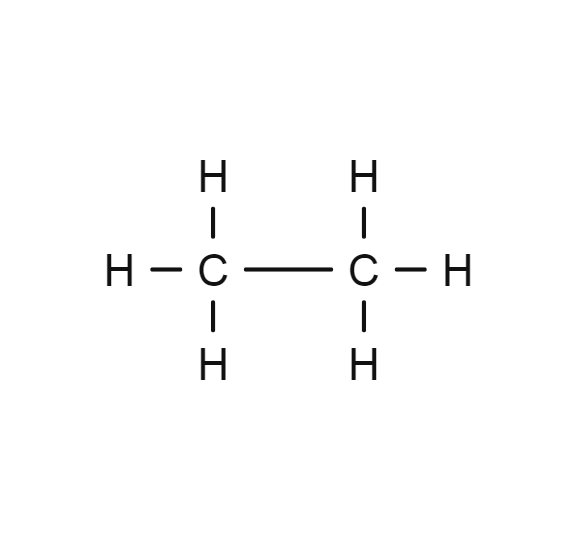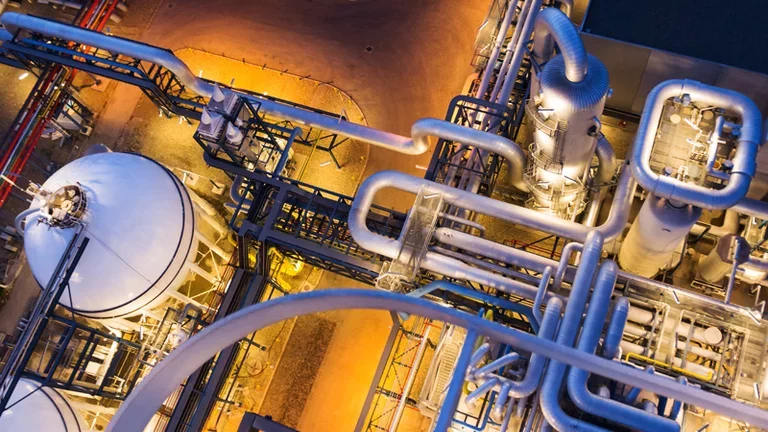
Ethane
- C2H6
- CAS Number 74-84-0
- UN1035 (gas)
- UN1961 (refrigerated liquid)
Click & drag to move the 3D molecule
Liquid / Gas Volumes
Calculate the volume or mass of a quantity of gas or liquid
Liquid Phase
At boiling point at 1.013 bar
Gas Phase
In standard conditions (1.013 bar, 15°C)
Physical Properties
Molecule phase diagram showing the transition phases between solid, liquid and gas as a function of temperature and pressure
-
- Molar mass 30.069 g/mol
- Content in dry air /
-
Critical Point
- Temperature 32.17 °C
- Pressure 48.72 bar
- Density 206.66 kg/m³
-
Triple Point
- Temperature -182.78 °C
- Pressure 1.13E-5 bar
Pressure 1.013 bar
| Latent heat of fusion (at melting point) | 95.081 kJ/kg |
| Melting point | - 183.3 °C |
Pressure 1.013 bar
| Boiling point | - 88.58 °C |
| Latent heat of vaporization (at boiling point) | 489.4 kJ/kg |
| Liquid density (at boiling point) | 543.83 kg/m3 |
| Compressibility factor Z | 9.9005E-1 |
| Cp/Cv ratio γ | 1.2093 |
| Gas density (at boiling point) | 2.054 kg/m3 |
| Gas density | 1.3547 kg/m3 |
| Gas/(liquid at boiling point) equivalent | 401.44 vol/vol |
| Heat capacity Cp | 1.6635 kJ/(kg.K) |
| Heat capacity Cv | 1.3756 kJ/(kg.K) |
| Specific gravity | 1.05 |
| Specific volume | 7.382E-1 m3/kg |
| Thermal conductivity | 17.961 mW/(m.K) |
| Vapor pressure | 23.8803 bar |
| Viscosity | 8.6129E-5 Po |
| Compressibility factor Z | 9.9156E-1 |
| Cp/Cv ratio γ | 1.1998 |
| Gas density | 1.2822 kg/m3 |
| Gas/(liquid at boiling point) equivalent | 424.14 vol/vol |
| Heat capacity Cp | 1.7188 kJ/(kg.K) |
| Heat capacity Cv | 1.4325 kJ/(kg.K) |
| Solubility in water | 4.556E-5 mol/mol |
| Specific gravity | 1.05 |
| Specific volume | 7.799E-1 m3/kg |
| Thermal conductivity | 19.741 mW/(m.K) |
| Vapor pressure | 33.7746 bar |
| Viscosity | 9.0594E-5 Po |
| Compressibility factor Z | 9.924E-1 |
| Cp/Cv ratio γ | 1.1939 |
| Gas density | 1.2381 kg/m3 |
| Gas/(liquid at boiling point) equivalent | 439.25 vol/vol |
| Heat capacity Cp | 1.7572 kJ/(kg.K) |
| Heat capacity Cv | 1.4718 kJ/(kg.K) |
| Solubility in water | 3.401E-5 mol/mol |
| Specific gravity | 1.05 |
| Specific volume | 8.077E-1 m3/kg |
| Thermal conductivity | 20.984 mW/(m.K) |
| Vapor pressure | 41.8744 bar |
| Viscosity | 9.3541E-5 Po |
Applications
Examples of uses of this molecule in Industry and Healthcare

Chemicals
Ethane is used in the production of organic synthesis intermediates, e.g. ethylene chloride is produced from ethane by the chlorination process.
Safety & Compatibility
GHS02
Flammable
GHS04
Gas under pressure
Autoignition Temperature, Flammability Limits & Flash Point
Europe (according to EN1839 for Limits and EN 14522 for autoignition temperature)
| Autoignition temperature (Chemsafe) | 515 °C |
| Lower flammability limit (IEC 80079-20-1) | 2.4 vol% |
| Upper flammability limit (IEC 80079-20-1) | 14.8 vol% |
US (according to ASTM E681 for Limits and ASTM E659 for autoignition temperature)
| Autoignition temperature (NFPA 325) | 472 °C |
| Lower flammability limit (NFPA 325) | 3 vol% |
| Upper flammability limit (NFPA 325) | 12.5 vol% |
Odor
none
Metals
| Aluminium | Satisfactory |
| Brass | Satisfactory |
| Monel | No data |
| Copper | No data |
| Ferritic Steel | Satisfactory |
| Stainless steel | Satisfactory |
| Zinc | No data |
| Titanium | No data |
Plastics
| Polytetrafluoroethylene | Satisfactory |
| Polychlorotrifluoroethylene | Satisfactory |
| Polyvinylidene fluoride | Satisfactory |
| Polyvinyl chloride | Satisfactory |
| Ethylene tetrafluoroethylene | No data |
| Polycarbonate | No data |
| Polyamide | Satisfactory |
| Polypropylene | Satisfactory |
Elastomers
| Butyl (isobutene- isoprene) rubber |
Significant swelling
Not recommended
|
| Nitrile rubber | Satisfactory |
| Chloroprene |
Significant swelling
Not recommended
|
| Chlorofluorocarbons | No data |
| Silicone |
Significant swelling and significant loss of mass
Not recommended
|
| Perfluoroelastomers | Satisfactory |
| Fluoroelastomers | Satisfactory |
| Neoprene | No data |
| Polyurethane | Satisfactory |
| Ethylene-Propylene |
significant swelling
Not recommended
|
Lubricants
| Hydrocarbon based lubricant | Satisfactory |
| Fluorocarbon based lubricant | Satisfactory |
Materials compatibility
Learn More
More information
Ethane was first discovered by Michael Faraday in 1834, when he electrolyzed a solution of potassium acetate. The name has been derived from "ether", which comes from Latin "aether" and Greek "aithēr", meaning "upper air."